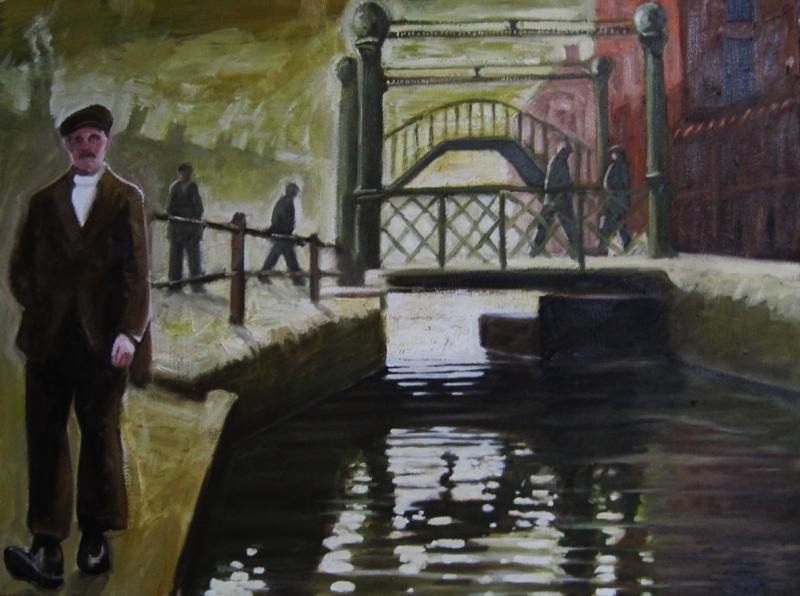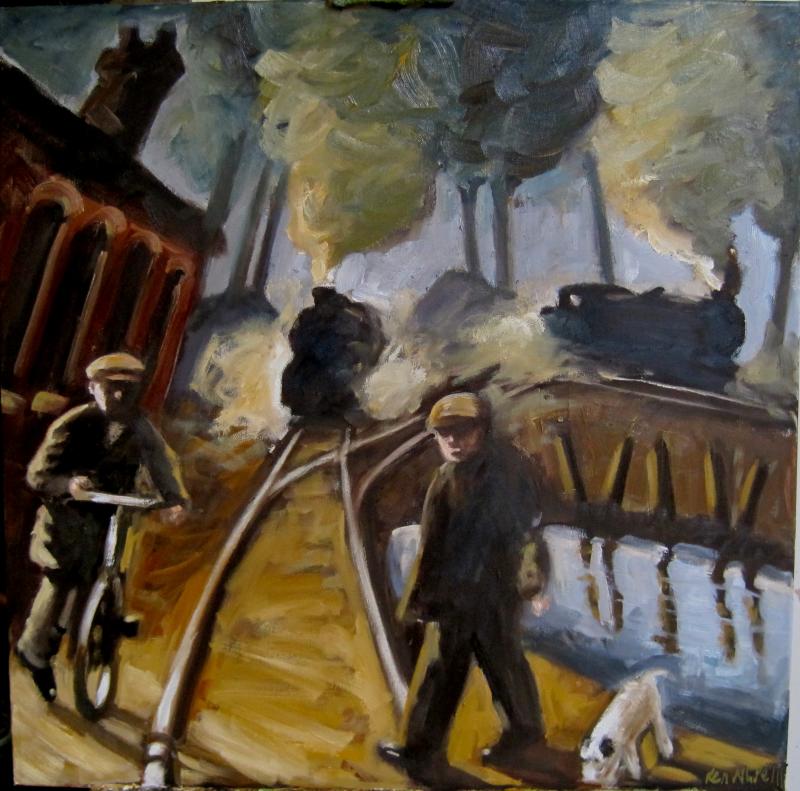It was inevitably a bit George Bowling,
A bit Coming up for Air,
Walking streets from which we once train-spotted,
Cries of disbelief at seeing diesel railcars still in chocolate and cream,
Waiting their turn for the scrapyard,
Marooned for the nonce in some distant siding,
High above the canal;
A Just William world, lost in space and time,
Both then, and now,
Searching for the palimpsests of inland navigations,
Lost where fields have become houses,
And where footpaths have become roads,
And where the North Wilts Canal became an underpass,
Under Brunel’s GWR main line,
Past red brick walls of what were once the confines of ‘The Works’,
Where 15,000 people were once employed,
Until you make your way across a main road,
To spot an edge-lands dark, narrow, footpath,
That seemed to disappear into a tangle of hawthorn,
But there, beyond the bags of rotting refuse,
The newspapers, magazines and the plastic detritus,
The sun gleamed in a suggestion of miry water,
That was once an inland navigation.
After a difficult journey past nettles and brambles,
With a tall wire fence on the other side of a gap
Only just wide enough for a body to pass through,
I reached the welcome wideness of the Wilts and Berks Canal,
To walk along a towpath of sorts,
The mainline to Kemble, Stroud, Gloucester and Cheltenham
High on my left, behind a rudimentary wire fence,
Warehouses to let, and factories of sorts, away on the other bank;
After about a quarter of an hour,
I reached the end of the extant waters,
To find the turnpikes’ revenge:
‘Swindon Car-Breakers’;
‘Specialist Ford Dismantlers’;
‘Cars and Vans Bought For Cash!
With or Without MOT!’;
I turned left for the road,
And there, beneath the notice board for ‘Highworth Breakers’,
Was a street name: Brindley Close.
Warmed by this canal reference, and the acrid, industrial taste of the air,
I decided to wander into Even Swindon
(Ernie Hunt!),
To seek out the River Ray,
Tributary of the infant Thames
(Once spanned by a canal aqueduct),
And the beautifully named Rushy Platt,
Making my way by instinct past a line of willow trees,
And an isolated old rusting corrugated barn,
Now surrounded by houses:
In short, I got lost in the vastness of West Swindon,
Roads were everywhere; everything new, alien and confounding,
Even the signpost was broken and shattered;
But a friendly walker directed me to a footpath
‘On the other side of Sainsbury’s car park’,
To make my way to Wootton Bassett Road,
And the Wilts and Berks Canal information board:
‘You are Here’.
A few minutes’ walk took me to a broad expanse of water,
Where a heron performed for me,
Until I reached the Midland and South Western Junction Railway bridge,
A tessellated red brick delight,
Then walked another quarter of a mile,
The hum of Swindon’s traffic an undercurrent all around,
To discover a stone bridge,
A picture of rural tranquility from a lost age,
Serenely commanding the silver clouded Wiltshire skyscape,
Despite the new Waitrose beyond, at a new brick bridge and railings;
I turned around at Waitrose
(I’ll explore further west another time).
The heron re-performed its tricks for me,
As I made my way along the line of the canal,
All bollards and parked cars and bridges and murals,
Cyclists, shoppers and the Shanghai by Cambria Bridge Road
(Once the cottage where Edward Thomas stayed with his grandmother),
Along a linear back yard in central Swindon,
Until it became Canal Walk, by the Brunel Shopping Centre,
Where periodic paving stones
Tell oblivious shoppers
The canal history of where they walk and talk and shop,
And a statue of a golden lion too,
In memory of the Golden Lion footbridge and lift,
Right slap bang there in the middle of Swindon’s shopping centre,
Two hundred metres or so before you reach Debenham’s,
The site of what was once a canal basin,
And junction of the North Wilts and Wilts and Berks canals.
I climbed up to Fleming Way
(A fast road line of the old canal, named after a Swindon footballer),
Past a canal mural on the gable end of a house,
Edwardian golden age near Corporation Street,
Then past the steps of what was once a canal bridge,
Hard by the Magic Roundabout and the County Ground;
This looks like the end of the journey,
But over beyond the football ground,
Just behind Queen’s Drive:
The start of Swindon’s GLC post-war overspill,
There is a footpath, where I remember water,
But though culverted now,
The linear woodland, the occasional puddles, the dampness, the gnats,
Remind us of what was once an inland navigation,
And after a couple of hundred metres,
There stands another stone bridge,
Again, one I had never seen before,
A reminder of a rural water-land,
In the midst of this urban rush;
The mission felt accomplished for the moment,
With a sense of temporary completion,
Until I resume my trek eastwards towards Berkshire;
But for now, back to the railway station:
‘We shall not cease from exploration, and the end of all our exploring will be to arrive where we started and know the place for the first time.’ T.S. Elliot
The Swindon Advertiser’s obituary for Edward Thomas, 1917:
‘His passionate love of the countryside was largely nourished in the neighbourhood of Swindon, along the Canal Side to Wooton Bassett, around Coate Reservoir, and elsewhere. No man has done more and, in more capable language painted the beauties of the environs of our town.’


 Stuart
Stuart